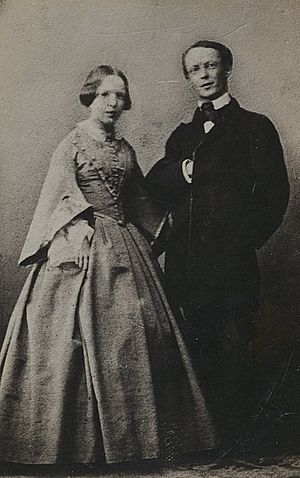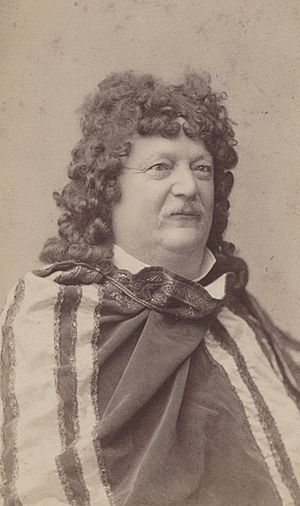Conrad Ferdinand Meyer facts for kids
Quick facts for kids
Conrad Ferdinand Meyer
|
|
|---|---|
 |
|
| Born | 11 October 1825 Zürich, Switzerland |
| Died | 28 November 1898 (aged 73) Kilchberg, Switzerland |
| Occupation | Poet, historical novelist |
| Language | German |
| Nationality | Swiss |
| Citizenship | 1867-1887 |
| Genres | Poetic realism, expressionism, comic novel, historical fiction |
Conrad Ferdinand Meyer (born October 11, 1825 – died November 28, 1898) was a Swiss poet and writer of historical novels. He was known for his realistic writing style. Many people remember him for his exciting story-poems called ballads, like "Die Füße im Feuer" (The Feet in the Fire).
Contents
About Conrad Ferdinand Meyer
Conrad Ferdinand Meyer was born in Zürich, Switzerland. His family was well-known and important in the city. His father, who passed away when Conrad was young, was a statesman and historian. His mother was a very educated woman.
As a child, Meyer showed two main traits. He was very careful about being neat and clean. Also, he often thought more deeply about past memories than about what was happening right then.
After finishing school, he started studying law. However, he was much more interested in history and other subjects like literature. He spent a lot of time traveling to places like Lausanne, Geneva, Paris, and Italy. In these places, he enjoyed doing historical research.
His travels in France and Italy in 1857 gave him many ideas. He used these ideas for the settings and characters in his historical novels. In 1875, he settled in Kilchberg, a town near Zürich.
Finding His Path as a Writer
Meyer found his true calling as a writer quite late in life. For many years, he could speak both French and German very well. He wasn't sure which language to write in.
The Franco-Prussian War (a big conflict between France and German states) helped him make his final decision. In Meyer's stories, a major crisis often brings out hidden strengths. It can also lead to big changes.
In the same way, the events of 1870 deeply affected Meyer's own life. Before the war, he had spent his time dreaming and trying different things. Meyer strongly supported the German side. To show his feelings, he published a short epic poem called Hutten's Last Days in 1871. After this, he started writing many works quickly.
In 1880, the University of Zurich gave him an honorary doctorate degree. This is a special award for his achievements. He passed away at his home in Kilchberg on November 28, 1898.
Meyer's Famous Works
Meyer's collected works were put into eight volumes in 1912.
Novels
Most of his novels are set during the Renaissance and Counter Reformation periods. These were times of great change in European history. His stories often explore the struggle between freedom and destiny. They usually build up to a dramatic moment. In this moment, the main character faces a big temptation. They might lose their moral freedom and be forced to follow a higher path.
- 1876 Jürg Jenatsch' – This story is set in Graubünden, Switzerland, during the Thirty Years War. It shows the conflict between Spain-Austria and France in the 17th century. The hero is a Protestant minister and a very patriotic person. He is determined to keep his small country independent. He even commits murder and treason to do so. His character mixes both noble and bad reasons for his actions.
- 1891 Angela Borgia' – This novel is set during the exciting time of the Italian Renaissance.
Novellas (Short Novels)
Meyer's most important works are his historical novellas. These are shorter than full novels but longer than short stories.
- 1873 Das Amulett (The Amulet) – This story takes place in France during the terrible St. Bartholomew's Day Massacre.
- 1878 Der Schuss von der Kanzel (The Shot from the Pulpit) – A story set in Switzerland.
- 1879 Der Heilige (The Saint) – This novella is about Thomas Becket and is set in England during the Middle Ages.
- 1881 Plautus im Nonnenkloster (Plautus in the Nunnery) – This story is set in Switzerland during the Renaissance period.
- 1882 Gustav Adolfs Page (Gustav Adolf's Page) – This novella is set during the Thirty Years' War.
- 1883 Das Leiden eines Knaben (The Suffering of a Boy) - This story is set in France during the reign of Louis XIV.
- 1884 Die Hochzeit des Mönchs (The Wedding of the Monk) – This story is set in Italy. The famous poet Dante himself tells the strange tale. It's about a monk who is forced to break his vows after his brother dies. But instead of marrying his brother's widow, he falls in love with another girl and faces a difficult fate.
- 1885 Die Richterin (The Judge) – This story is set in the Carolingian time in Grisons. It features Charlemagne and his palace school.
- 1887 Die Versuchung des Pescara (The Temptation of Pescara) – This novella is set in Renaissance Italy. It tells about a big challenge in the life of Fernando d'Ávalos. He was a general for Charles V.
Lyrics (Poems)
- 1867 Balladen (Ballads)
- 1870 Romanzen und Bilder (Romances and pictures)
- 1872 Huttens letzte Tage (Hutten's Last Days) – A short epic poem.
- 1873 Engelberg
- 1882 Gedichte (Poems)
Meyer's Legacy
Meyer is mostly remembered as a master of narrative ballads. These are poems that tell a story, often about historical events. His fiction also usually focuses on important historical moments. These include times from the Middle Ages, the Reformation, and the Counter-Reformation.
Most of Meyer's lyric poems were written later in his life. He often wrote about things made by human hands, especially works of art. The city of Rome and the amazing work of the artist Michelangelo were very important experiences in his life.
See also
 In Spanish: Conrad Ferdinand Meyer para niños
In Spanish: Conrad Ferdinand Meyer para niños
- Family romance



